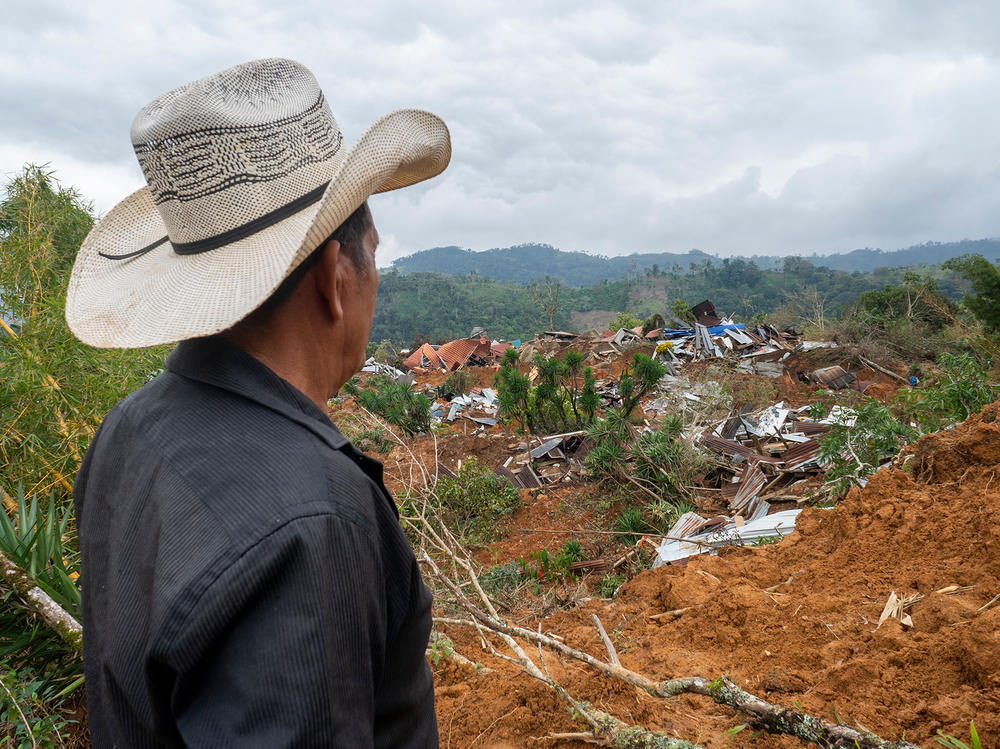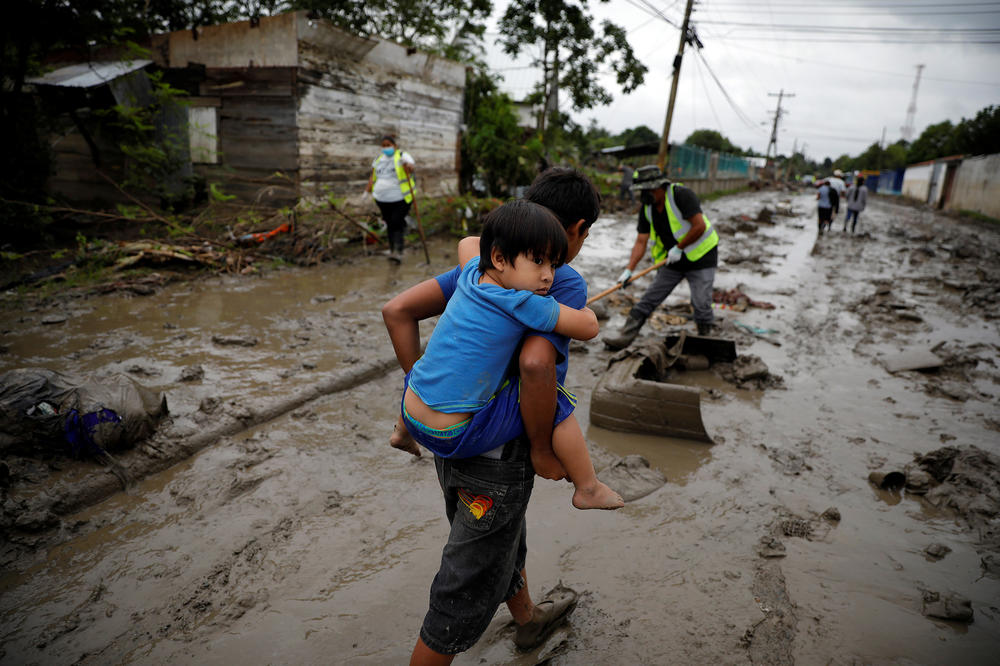Section Branding
Header Content
Even Disaster Veterans Are Stunned By What's Happening In Honduras
Primary Content
Even disaster experts are stunned by the devastation this fall in Honduras.
"I've been to too many disasters all over the world," says Vlatko Uzevski, who arrived in Honduras last week from Macedonia to lead an emergency response team for Project Hope.
"And I have never been to a place that was struck by two hurricanes in two weeks," says Uzevski, a physician who has been doing this type of work for 15 years.
The two Category 4 hurricanes – Eta and Iota — made landfall in Central America on Nov. 3 and Nov. 17, respectively. Even today, the region continues to dig out from mudslides. Aid agencies say nearly 7 million people in a zone stretching from Colombia to Mexico are in need of assistance.
Despite both hurricanes initially coming ashore in Nicaragua, neighboring Honduras appears to have suffered the most damage and the most deaths from landslides and flooding caused by the intense rainfall. The cyclones slowed over Honduras, and being the last two named storms of a record-breaking hurricane season, they dumped precipitation on already saturated hillsides.
This week in a nationally broadcast address, Honduran President Juan Orlando Hernández assured his people, "No están solos," meaning "You are not alone."
The storms destroyed bridges, roads, schools and health clinics. Families lost their homes, farms and businesses to floodwaters. Landslides packed small downtown plazas with mud.
Hundreds of thousands of Hondurans remain homeless. Many are crowded into shelters. Others are staying with friends and relatives.
Hernández announced a plan to invest four times the nation's annual budget in infrastructure and social programs to help Hondurans recover from the devastating storms.
"This investment will generate jobs, jobs that so many need, and it will put money into the pocket of hondureños," the president said. "It will rebuild the dignity of hundreds of thousands of workers who because of the pandemic and now the storms lost their jobs, their homes."
He said Honduras has been battered this year by a combination of forces like no time in its history.
Uzevski is leading an emergency response team in the Santa Barbara department in northern Honduras for Project Hope.
The Santa Barbara department is one of the 18 departments or states in Honduras. It's just east of the nation's second-largest city, San Pedro Sula. Santa Barbara was hit hard by the rains and ensuing mudslides of Eta and Iota.
"The water system of the Santa Barbara department is 100% collapsed," he says. Helping set up temporary water distribution points is one of the things Project Hope is working on in the area.
According to government figures, there are 118 official shelters in the Santa Barbara department, holding nearly 6,000 people. Uzevski has been touring some of them to get a better sense of the needs of people displaced by the storms.
He says one of his first concerns was how COVID-19 might be spreading at the shelters.
"I'm really paying attention on this side of the story," he says. "And I was really happy to see signs (at the shelters) saying, 'Wear mask! Wear mask!' and 'Don't enter the shelter without mask.' "
He says not everyone is wearing masks but most are. And volunteers running the shelters are actively trying to minimize the spread of COVID-19 by spacing out mattresses on the floor as much as they can and aligning them so people sleep head to toe rather than face to face.
"They are trying to follow these rules," he says, emphasizing the word trying. "But the problem is this [COVID-19] is their secondary problem. These are people that lost their homes and they moved here. They lost everything that they had."
Worrying about COVID-19 isn't at the top of their priority lists. Yet cases are being detected among the displaced.
"We were seeing shelters where you have like 15 people who'd tested positive," Uzevski says. "And now they're trying to isolate them as much as possible."
Aid officials say that the damage from hurricanes Eta and Iota rival that caused by Hurricane Mitch, one of the deadliest Atlantic storms of all time. Mitch hit Honduras in 1998, leaving 3 million people homeless and prompting tens of thousands of Hondurans to migrate to the United States.
"The damage in terms of costs, destruction, damage to agriculture is just as high" as from Mitch, says Hugo Rodriguez, U.S. deputy assistant secretary of state for Central America, about Eta and Iota. "This is Mitch-scale if not bigger." The United States through the U.S. Agency for International Development has pledged millions of dollars to help respond to the crisis.
And it's not just Honduras. The record-breaking hurricane season displaced even more people in Guatemala.
Steve McAndrew, deputy regional director for the International Federation of Red Cross and Red Crescent Societies, says his agency has relief operations in response to Eta and Iota now in seven countries.
"Hurricane Eta affected almost all of Central America, including Panama, Costa Rica, Guatemala, Honduras, Belize and Nicaragua," he says. "And then the second hurricane Iota also had a direct hit on the San Andrés islands, which are part of Colombia. There's heavy damage, and the region's been heavily affected."
And for relief agencies, such as the Red Cross, the coronavirus pandemic makes getting help to people affected by a disaster far more difficult. McAndrew says COVID-19 travel rules make it hard to get relief teams in to disaster zones.
"There are restrictions around testing and entrance and exits," he says. "It's a changing patchwork every day. So now we struggle to get specialty teams in from one country to another. In the past, we could get them within 12 to 24 hours."
So far aid officials haven't seen a spike in COVID-19 cases linked to the shelters and the aftermath of the hurricanes. But many of these areas are still without power. Testing wasn't widespread even before the storms. McAndrew says it may take awhile to see the official bump in coronavirus infections, but he's sure it's coming.
"There's people on ferries just being rescued in all the low-lying areas of Central America," McAndrew says. "They're cramming as many people as they can on these boats and going back and doing multiple trips. That cannot be good. That cannot make the COVID situation better."
Copyright 2020 NPR. To see more, visit https://www.npr.org.


